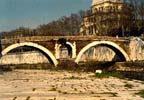 |
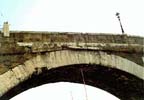 |
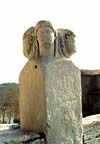 |
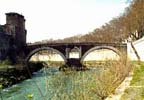 |
| #1 | #2 | #3 | #4 |
| Rome: Main Page | Arch of Constantine | Colisseum | Roman Forum | Ostia | Herculaneum |
| FJ's Homepage | Asclepius Images/Sites | Imperial Fora | Tiber River | Other Rome Sites | Pompeii |
[see below for descriptions of all the Ancient Tiber Bridges, listed in geographical, chronological, and alphabetical orders]
click on any picture below to see a larger image
 |
 |
 |
 |
| #1 | #2 | #3 | #4 |
#1 - Pons Fabricius, connecting the Tiber Island with the left bank (East)
of the Tiber; mid-day view looking north; whole bridge is ancient
#2 - Close-up of the inscription mentioning "Fabricius" at the top of the
western arch
#3 - The "Quattro Capi" (four-headed pilaster) at the East end of the Pons
Fabricius
#4 - late-afternoon view of Pons Fabricius, looking north from the East bank
of the Tiber
 |
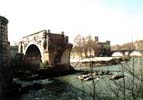 |
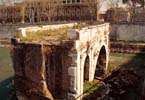 |
| #5 | #6 | #7 |
#5 - Pons Cestius, connecting the Tiber Island with the right bank of the
Tiber; mid-day view looking north; only the central span is ancient
#6 - single remaining span of the ancient Pons Aemilius, standing mid-stream
just South of the Tiber Island; view from the East bank
#7 - another view of the Pons Aemilius; from the adjacent modern automobile
bridge
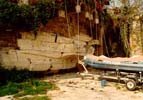 |
 |
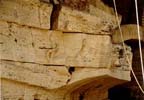 |
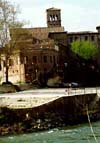 |
| #8 | #9 | #10 | #11 |
#8 - Remains of an "Asclepius Ship" carved into the travertine walls of the
south-east side of the Tiber Island
#9 - Close-up showing details of Asclepius' staff, snake, and hair
#10 - Another close-up of the same
#11 - View from a distance; note the "ship" in the middle of the picture,
far above the river's present level
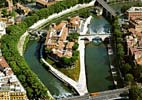 |
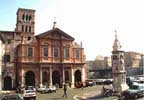
|
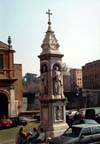
|

|
| #12 | #13 | #14 | #15 |
#12 - Aerial view of the Tiber Island and bridges (from a commericial postcard,
of course).
#13 - Basilica of San Bartolomeo (ca. 1000 A.D.), built on the site of an
ancient Roman shrine to the healing god Asclepius
#14 - Four-sided Pillar in the Piazza in front of the basilica
#15 - Interior view of the Basilica (from a postcard)
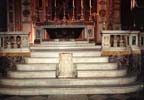 |
 |
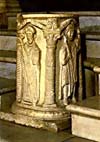 |
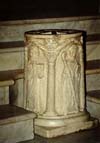 |
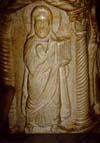 |
| #16 | #17 | #18 | #19 | #20 |
#16 - Interior view of the church, showing the medieval well on the site
of the ancient Asclepius shrine
#17 - Close-up of the well, viewed from the front.
#18 - Close-up of the well, showing the carvings on the north and west sides
#19 - Close-up of the well, showing the carvings on the north and east sides
#20 - Close-up of the carving of Jesus on the east side of the well

|

|

|

|
|
|
|
|
|

|

|

|
|
|
|
|
#21-23 - three views from the Northwest (downstream on the right bank) of
the Pons Mulvius (now also called Ponte Milvio or Ponte Molle)
#24 - one view from the Southwest (downstream on the left bank) of the two
most ancient arches of the Pons Mulvius
#25-27 - closeups of some of the best-preserved ancient arches on the southern
end of the Pons Mulvius
Many of the Ancient Roman bridges were partially modified or destroyed during
construction of the present river embankments in the 1880's and 90's, but
some portions still remain. Here are all the ancient bridges, listed in both
chronological order (oldest to youngest) and geographical order
(from North to South), with descriptions of each bridge in alphabetical
order below the chart. Alternate ancient and medieval [and modern]
names are also given for each bridge.
| Chronological Order (from Oldest to Youngest)... | Geographical Order (from North to South)........ |
| 1) Pons Sublicius | Pons Mulvius = Pons Milvius |
| 2) Pons Mulvius = Pons Milvius | Pons Aelius = Pons Hadriani |
| 3) Pons Aemilius = Pons S. Mariae | Pons Neronianus = Pons Triumphalis |
| 4) Pons Fabricius = Pons Iudaeorum | Pons Agrippae |
| 5) Pons Cestius = Pons Gratiani | Pons Aurelius = Pons Antoninus |
| 6) Pons Agrippae | Pons Fabricius = Pons Iudaeorum |
| 7) Pons Neronianus = Pons Triumphalis | Pons Cestius = Pons Gratiani |
| 8) Pons Aelius = Pons Hadriani | Pons Aemilius = Pons S. Mariae |
| 9) Pons Aurelius = Pons Antoninus | Pons Sublicius |
| 10) Pons Probi = Pons Theodosii | Pons Probi = Pons Theodosii |
Most of these bridges spanned the entire river, except for two which lead to/from the Tiber Island. Pons Fabricius connects the island and the left (East) bank and Pons Cestius connects the island and the right (West) bank. Click here for an Interactive Map of Ancient Rome, with a drop-down menu that allows you to see the location of numerous sites, including eight of the ancient bridges. Or click here for Another Clickable Map of Rome, from ItalyCyberGuide, including their useful Index (see "Ponte").
Brief Descriptions of Each Bridge:
(prefixed numbers refer to chronological order, as in table above; but
listed below in alphabetical order by original name)
8) Pons Aelius = Pons Hadriani = Pons S. Petri [modern Ponte S. Angelo, by Hadrian's Mausoleum]
Note: For more information, the hyperlinks on most of the above bridges (and for the Tiber Island) will take you to the appropriate articles from Samuel Ball Platner's A Topographical Dictionary of Ancient Rome [Oxford University Press, 1929], now in the public domain, and generously put on-line by William P. Thayer. (Thanks, Bill!) See also his page on other Roman Bridges, and his collection of Roman Bridges: Web Links.
See also another website dedicated to the Tiber Island,
http://www.isolatiberina.it,
maintained by Bruno Leoni, a native of Rome.